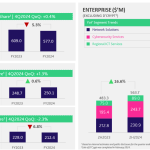While the deal is still pending IMDA’s regulatory approval, the chances of it going through appear quite high. The announcement has already made waves in the market, with StarHub’s share price dropping 4.9% to S$1.16 amid speculation that StarHub was originally eyeing M1 as an acquisition target. Singtel’s share price also dipped by 1% to S$3.94
If the merger proceeds, SIMBA and M1 will have a consolidated subscriber base. In prepaid and broadband services, they would still trail behind both Singtel and StarHub. However, in the postpaid segment, the combined entity is expected to hold 38.3% market share—just 0.4% shy of Singtel’s 38.9%—making it the second-largest telco in Singapore. With SIMBA’s aggressive pricing strategy, more subscribers could be tempted to switch, especially as the merged network could offer 5G SA via M1’s 100 MHz n78 band (currently shared with StarHub).
The acquisition would also give both SIMBA and M1 users access to a wider pool of frequency bands. This includes LTE Band 3 and Band 7, already deployed by M1’s shared antenna system in buildings and MRT tunnels, as well as the n78 and n1 bands for 5G SA, and LTE Band 28 (700 MHz) for deeper coverage. Conversely, M1 customers could also tap into SIMBA’s LTE Band 8, Band 40, and Band 38, further expanding coverage for both networks.
What remains uncertain is whether IMDA will require the merged entity to return any excess spectrum, or allow them to retain all bands. Another key question involves the n78 band, currently operated under the joint venture Antina—will Antina be dissolved, and if so, who will take control of the 100 MHz spectrum? Could it be split evenly, with StarHub and SIMBA each holding 50 MHz?

Band Allocation per telco
Currently, SIMBA and M1 has these bands. Currently, Singtel has the most bandwidth. Starhub and M1 has shared n1 and n78. After merger, some spectrum might need to be returned.
The combined SIMBA/M1 will have 90 MHz + 180 MHz (assuming n1 and n78 is split back to 10×2 and 50). A total of 270 MHz which is still lower than Singtel (355 MHz) but slightly more than Starhub of 210 MHz.
SIMBA
B8 900 MHz – 10 MHz x 2
B38 2600 MHz – 10 MHz
B40 2300 MHz – 40 MHz
n1 2100 MHz – 10 MHz x 2
Total : 90 MHz
M1
B28 700 Mhz – 5 MHz x 2
B3 1800 MHz – 20 MHz x 2
B7 2600 MHz – 20 MHz x 2
B8 900 MHz – 5 Mhz x 2
n1 2100 MHz – 25 MHz (shared with Starhub) x 2
n78 3500 MHz – 100 MHz (shared with Starhub)
Total : 100 MHz + 50 MHz (n1) + 100 MHz (n78) or 100 MHz + 20 Mhz (n1) + 50 MHz (n78)
= 250 MHz or 170 MHz
Singtel
B28 700 MHz – 20 MHz x 2
B8 900 MHz – 10 MHz x 2
B3 1800 Mhz – 30 MHz x 2
B7 2600 MHz – 20 MHz x 2
B38 2500 MHz – 15 MHz
n1 2100 MHz – 25 Mhz x 2
n78 3500 MHz – 100 MHz
Total : 325 MHz
Starhub
B28 700 MHz – 10 Mhz x 2
B8 900 MHz – 5 Mhz x 2
B3 1800 Mhz – 25 MHz x 2
B7 2600 Mhz – 20 MHz x 2
B38 2500 Mhz – 20 MHz
n1 2100 Mhz – 25 MHz (Shared with M1) x 2
n78 3500 MHz – 100 MHz (Shared with M1)
Total : 140 MHz + 50 MHz (n1) + 100 MHz (n78) or 140 MHz + 30 MHz (n1) + 50 MHz (n78)
= 290 MHz or 220 MHz

There is a high chance that SIMBA and M1 will implement MOCN before consolidating the networks. That is SIMBA and M1 users will be able to tap on each other’s network. That will greatly improve coverage especially blind spots in buildings. SIMBA users might finally have the chance to have a taste of high speed 5G SA with the n78 spectrum.




